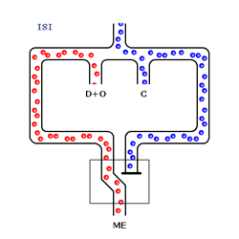A 8-channel olfactometer for accurate and controlled administration of odours to participant. This instrument can be used in combination with our 3T MRI for functional MRI studies.
Principle
An olfactometer is a machine designed to deliver odours in a precisely-controlled manner, for instance in order to objectively assess olfactory function (‘ability to smell’) in a participant. This olfactometer provides a constant flow of air via a small tube to the nose of the participant. The air flow is heated to body temperature and humidified to > 60% relative humidity to prevent any thermal irritation and ensure that the nasal mucosa does not dry out.
The Burghart olfactometer works according to the Kobal switching principle. In this switching principle – schematically depicted below -, all flows are conveyed to the switching device: control (non-odorous air), dilution (non-odorous air) and odorant (odorous air).

During the inter-stimulus interval, the mixture of odorant and dilution is removed by means of a vacuum flow, and only the control flow reaches the participant’s nose.
During stimulation, it is the control flow that is removed by means of a vacuum flow, and the mixture of odorant and dilution air flows into the participant’s nose.